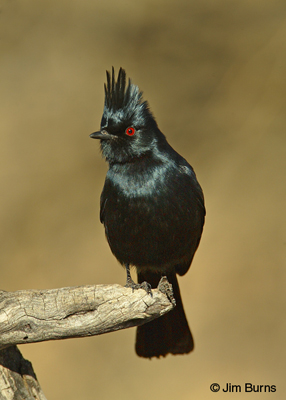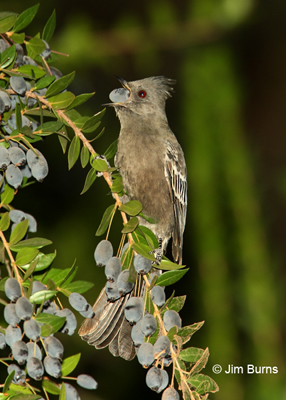
Let’s pose it as a nature trivia question. Name the only North American bird known to nest in two completely different habitats in the same breeding season! As some of you undoubtedly know, the answer is our beautiful, fascinating, and nomadic “shining robe,” Phainopepla nitens, the Phainopepla.
If you happen to tube the Salt River or hike through the mesquite bosques along the Verde between now and football season, you’ll notice the Black Cardinals abundant there in our spring have become conspicuous by their absence. There’s a reason for that. In the Arizona deserts, Phainopeplas are early spring nesters, their first breeding timed to coincide with the peak of the mistletoe berry crop and the first insect hatchings of the year. When the deserts begin to heat up in late spring they migrate up into the oak/chaparral foothills to raise a second brood in cooler, damper habitat.
During the initial nesting season, last week of February to first week of April, Phainopepla nests are built, almost exclusively by the male, in mesquite, usually deep inside a clump of mistletoe on a mesquite. Mistletoe and mesquite have a parasitical relationship, mistletoe and Phainopeplas a commensal one. Mistletoe berries, the favored food of this species, pass quickly through the birds’ digestive systems and form a sticky excrement that attaches the plant’s seeds to the trees where the birds perch, continuing the cycle of mistletoe parasitism on the mesquites.
Not nearly as much is known about this species’ summer nesting which peaks in early June, but there are three hypotheses. The first suggests the same breeding birds nest in the desert, migrate the short distance to summering habitat, then nest again. The second proposes two separate populations, one breeding in spring deserts, the other in summer woodlands at slightly higher elevations, both migratory, the former moving to cooler summer habitat, the latter moving to winter mistletoe berry concentrations. The presence of non-breeding birds in both breeding seasons supports this theory. The third possibility is that the birds breeding in June are simply those that were unsuccessful in March, implying that individual birds actually breed only once a year.
One June I hiked up Sonoita Creek from the mesquite bosques of Patagonia Lake State Park almost to the Circle Z property line without seeing a single Black Cardinal. As I rounded the last bend, I came upon perhaps thirty of them, males, females, and young of their first spring, flycatching in a feeding frenzy over the creek. This lasted over an hour, then all disappeared, nomads in search of the next fruiting trees or bug hatch to fuel their second spring.